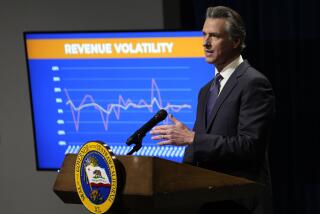Spending Cap Would Shift Power
- Share via
SACRAMENTO — When Gov. Arnold Schwarzenegger presented lawmakers with a plan to impose a permanent spending cap on state government last month, it was described as a necessary step to bring finances under tighter control.
The plan would attempt to end the Legislature’s habit of spending more money than the state collects in revenue by establishing a ceiling tied to fluctuations in California’s population and per capita income.
It would also give Schwarzenegger -- and future governors -- a dramatic new authority to make budget cuts without first winning legislative consent.
Lawmakers in both parties objected to the constraints, regarding them as either not tough enough or so tough they would handcuff the Legislature and strip away its most important constitutional responsibility -- administering the budget.
Now lawmakers are racing to find an alternative they can endorse in time to put a constitutional amendment on the March ballot so voters can decide the issue.
Schwarzenegger has signaled his willingness to compromise, but his plan remains the starting point for talks:
* Under the proposal, state revenues for the coming year would be estimated by the governor’s own director of finance. In Schwarzenegger’s case that would be Donna Arduin. The finance director would have sole responsibility for determining when expenditures exceed the spending cap and whether there is a revenue shortfall that constitutes a fiscal emergency. The Legislature would then be required to live within those declarations.
* The proposal would expand a governor’s power to independently address fiscal problems by allowing the chief executive to make midyear budget cuts that would take effect in 30 days unless a two-thirds majority of the Legislature came up with alternative spending reductions.
The new powers given the governor and his finance director, nonpartisan Legislative Analyst Elizabeth Hill reported this week, “have the potential to fundamentally shift the balance of power between the executive and legislative branches of government.”
* Once a budget was put in place, any new revenue that came to the state -- as happened this year when fall tax receipts came in about $2 billions over projections -- would be diverted to a budget stabilization fund, a sort of rainy day reserve. That fund could be touched only to provide tax rebates, pay debt service on deficit bonds, cover past revenue shortfalls or finance emergencies decreed by the governor with legislative consent.
* The rainy day reserve, however, would alter provisions in Proposition 98, a constitutional amendment that, among other things, currently requires that half of any new state revenue be applied to K-12 public schools and community colleges. Analyst Hill estimated that the rainy day reserve would probably tap about $2 billion a year that otherwise would go toward education.
On the other hand, Hill also said that if money from the rainy day reserve were used to assist the budget’s general fund in bad economic years, the spending cap could actually stabilize education accounts because the per capita income index is less volatile than personal income tax receipts. Each year, Proposition 98 requires that roughly 40% of the general fund be dedicated to education.
* Hill said the governor would have the power to declare a fiscal emergency and address it with spending cuts or tax hikes. Lawmakers could override the action by agreeing on alternative actions.
Hill, whose job is to advise the Legislature, pointed to some potential pitfalls in the governor’s spending cap. She said Schwarzenegger’s plan would force the state to live within its means by requiring that general fund spending not exceed revenues in the fiscal year that begins July 1.
Without changes in law, she predicted state spending would exceed revenues by $15 billion in the coming budget year. She noted that actions taken to close this gap “will to a large degree lock in future revenue and expenditure levels.” Hill questioned whether it is reasonable to do so in the next budget.
State Sen. Jack Scott (D-Altadena) is among many Democrats who fear a cap based on projected revenues for the coming year only, as the state struggles to emerge from a recession. He said it makes more sense to take the average state revenues over the last five years and base a spending limit on that.
“If you looked at revenues over a five-year period you would come up with a much better base,” Scott said.
“I don’t want to put us in a straitjacket so three years down the road we can’t meet legitimate needs of state.”
More to Read
Get the L.A. Times Politics newsletter
Deeply reported insights into legislation, politics and policy from Sacramento, Washington and beyond. In your inbox twice per week.
You may occasionally receive promotional content from the Los Angeles Times.











